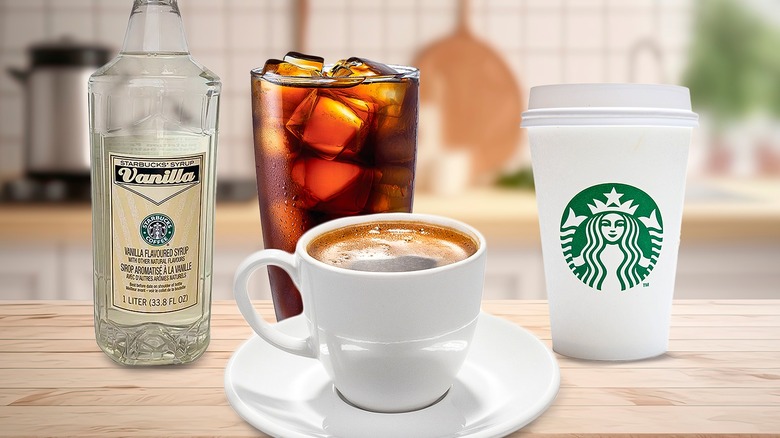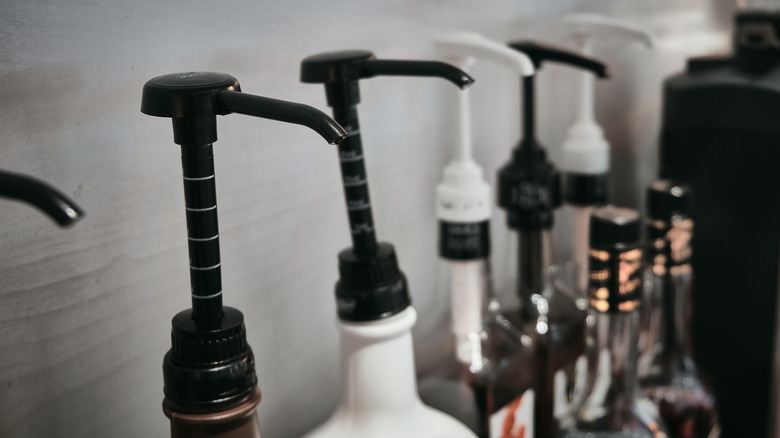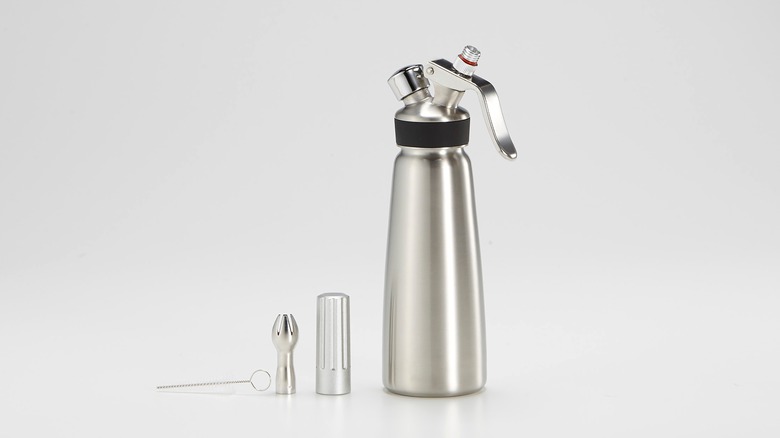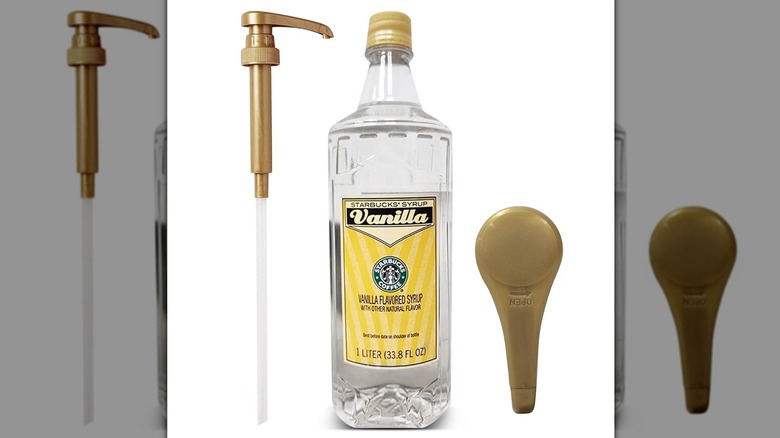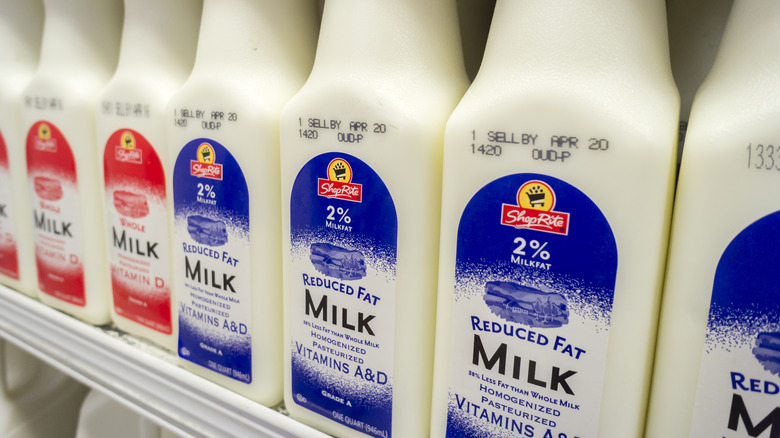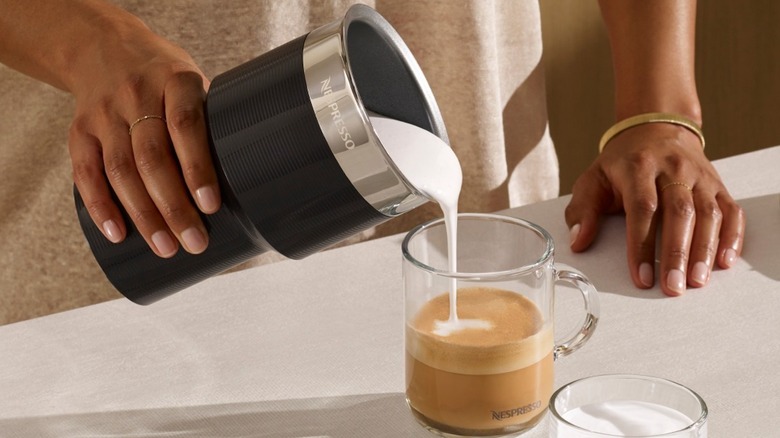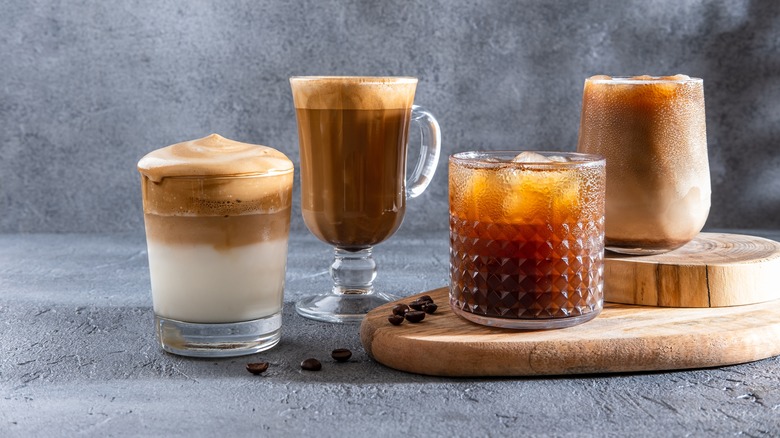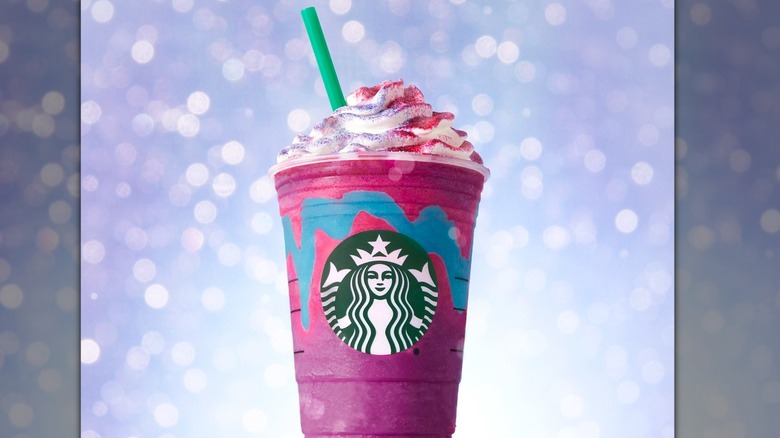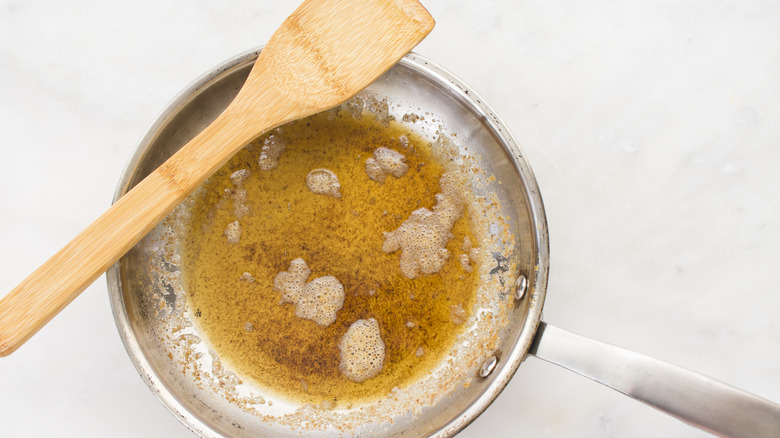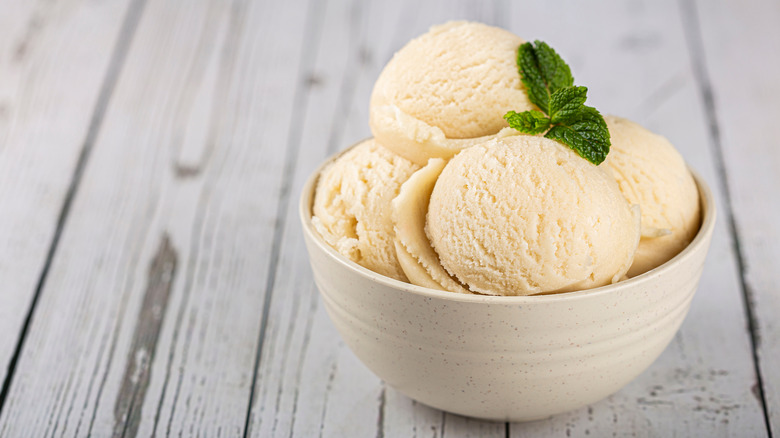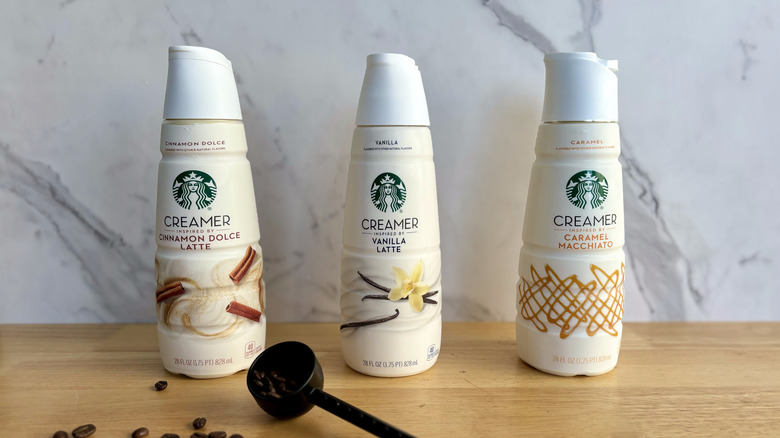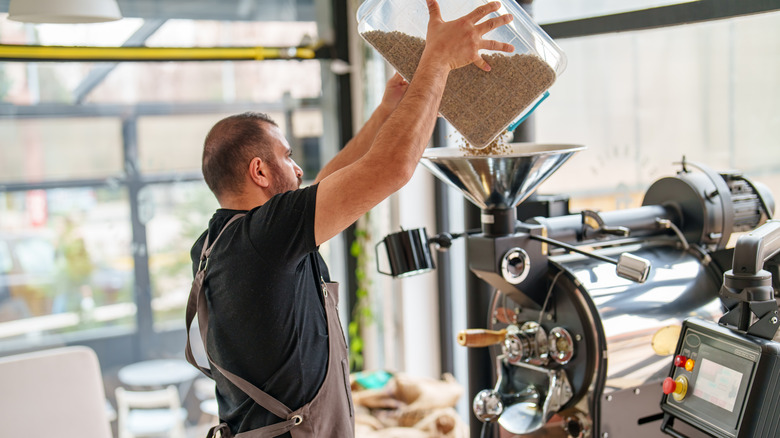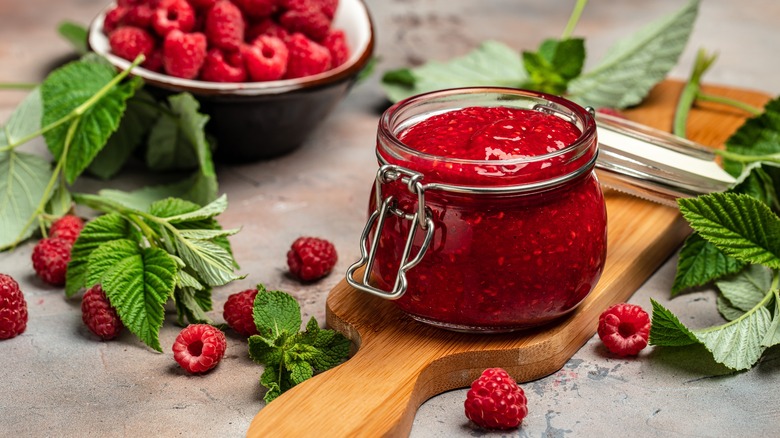12 Tips You Need For Recreating Starbucks Drinks At Home
If you've ever watched baristas at Starbucks prepare drinks with seemingly second-nature ease, you may have wondered how they manage it. With such an extensive menu, the memorization alone feels monumental. However, one of the first things you learn as a Starbucks barista is that the drinks and their recipes follow a well-defined pattern. This pattern makes it easy for baristas to learn new drinks as they are introduced to the menu throughout the seasons, and it also helps them work quickly behind the bar and at the Frappuccino blender. Although these sequences become second nature to baristas over time, they may seem like an entirely different language if you've never worn the green apron.
I frequently see people on social media believing they are leaking Starbucks recipes, when in reality, all that's being released are recipe cards that are easy to figure out if you know a few simple concepts. In many cases, paying close attention to the different components of a drink right in the Starbucks app will tell you almost everything you need to know about what is actually in a drink. From there, it's all about making the right choices with your ingredients. So, if you're hoping to save a bit of cash and learn how to make Starbucks-quality — and sometimes even better — drinks right in your kitchen, I have a few tricks tucked away in my apron as a former Starbucks barista.
Know the pump numbers
A big piece of the Starbucks recipes is a pretty systematic ratio when it comes to syrup pumps. That is, for each drink size, there's a certain number of syrup pumps that go into the drink. One of the first things you'll need to know when crafting those drinks at home is to replicate the same number of pumps, all dependent on the size of your drink.
To do this, you'll first want to know the size of your beverage container and its equivalent in Starbucks terms. A 12-ounce mug or cup will amount to a tall, 16 ounces is a grande, and a venti is two different sizes depending on whether you're making a hot or iced drink. A hot venti is 20 ounces, while an iced version is 24 ounces.
The syrup pumps in cafes distribute about ½ ounce of syrup with one pump, so you'll multiply that half ounce by the number of pumps baristas use in stores for each size. For Starbucks syrup flavors, a quick app study shows that a hot Starbucks drink has three, four, or five pumps in a tall, grande, or venti. An iced one has the same number for the tall and grande, but a venti goes up to six pumps. Knowing the right amount of syrup will help you achieve the right flavor mixture within your drink.
Make your own whipped cream
There are many different ways to make whipped cream. At Starbucks, baristas don't rely on store-bought containers like you would find in the grocery store. Rather, they pour heavy whipping cream with vanilla syrup into a whipped cream canister container pumped full of CO2. You can find similar ones on Amazon that will achieve something similar by adding whipping cream and vanilla coffee syrup to the canister.
Investing in one of these will make your whipped cream taste very similar to the good stuff in Starbucks cafes. If you don't have vanilla coffee syrup, do not opt for vanilla extract, as it will not produce the same effect. Instead, take a few extra steps to use that vanilla syrup to make your own coffee syrup, but don't use it on its own. Plus, when you have your own whipped cream canister, you can make whipped cream with other coffee syrup flavors you may have on hand. Not to mention, whipped cream makes a delicious substitution for creamer.
Purchase or make Starbucks syrups
If you want the exact same flavoring in your Starbucks drinks, you may be interested in purchasing the actual bottles Starbucks baristas use in stores. It's a little-known fact that you can — politely — ask to purchase Starbucks bottled syrup right in the cafe or online through retailers like Amazon. Though you'll get a lot of use out of one bottle, with a price increase to $19.95, these syrups tend to be a little pricier than other brands.
Unfortunately, asking a barista to purchase a bottle doesn't guarantee that you'll be walking out with your favorite flavor in hand. Depending on availability, you may find that your Starbucks barista says no when you ask to purchase a bottle. I've noticed that if the syrup is super popular, in short supply, or seasonal, there's a high chance you might walk out empty-handed. Of course, you could always make your own coffee syrups using ingredients you probably already have on hand, like sugar, water, and vanilla extract to make vanilla syrup, for example.
Use the right kind of milk
Until the summer of 2007, Starbucks used whole milk as its base milk for espresso drinks. That summer, the brand switched to 2% milk, so unless you're making milk changes to your drinks, you should reach for 2% milk in most cases.
That said, if you're putting together an Iced Brown Sugar Oatmilk Shaken Espresso drink, you'll want to use oat milk instead, as the drink's name calls out. In most cases, when a drink uses a different kind of milk, it'll be mentioned in the name, making it easier to remember.
The flat white (which is different from the cafe late) is a notable exception to this rule. Instead of using 2% milk, flat whites use whole milk. So, if you're aiming to create a flat white, you'll use whole milk at home, just as baristas use in cafes. Of course, you can also make substitutions for your drink order that would result in a creamier drink. Using the term "breve," for example, will have your drink made with half-and-half, producing a creamier and milkier drink.
Steam your milk
If you've been making lattes and cappuccinos at home by warming your milk in the microwave or a pan on the stove, you may have felt there was a significant texture missing from the process. That you're sensing is the result of warming and steaming milk. In cafes, Starbucks baristas use steaming wands to heat your milk. The wands warm and aerate the milk, creating tiny bubbles to create that foam you may be used to seeing on lattes and cappuccinos.
This steaming makes the milk even creamier and adds a dreamy sort of texture to the drink. If you have access to an espresso machine with a steaming wand, that will be the best way to replicate the process, but these can be pricey. For something a little more reasonable, consider Nespresso's Aeroccino machine. These do an excellent job of warming and aerating the milk. You'll find that they get pretty close to what you're used to enjoying in Starbucks locations. Plus, you won't need to monitor the milk the whole time it's steaming as baristas need to do with the wands. Instead, the Aeroccino will stop when it's done with the job.
Use espresso as a coffee base
Another important consideration for making coffee drinks is using the right base. That is, for espresso drinks, espresso, rather than brewed, drip coffee is an absolute must. If you have an espresso machine, this is easy, but like so many coffee tools, espresso machines can be pricey. Some are a little more reasonably priced, but I have found that an Aeropress coffee tool actually creates pretty solid espresso-like that works great as a substitute.
My process for creating roughly two espresso shots in volume uses 18 grams of coarsely ground espresso and 115 grams of water warmed to 195 F. I have found that when I use this as my espresso base, it works perfectly. You'll also want to use a very dark roast in your coffee. To get the richest flavor, it is best to get whole-bean coffee and then grind it on your own. You can get an electric grinder, but I love my 1ZPRESSO coffee grinder. With so many different settings, you can grind coffee, perfect for pour-over, espresso, and even cold brew. This is ideal because, of course, there are Starbucks coffees that do not use espresso as a base. If you like Starbucks cold brew, for example, you'll want to make sure you use actual cold brew to achieve a similar drink. You can purchase Starbucks cold brew in stores or even make your own.
Bring back the unicorn Frappuccino with Fun Dip
Starbucks often announces drinks that stay on the menu for only a season. Then, there's a whole other category of drinks that are far more limited and available for an even shorter time, as was the case with the fleetingly available Starbucks Unicorn Frappuccino. Now, you can pull one of these mythical treats together in your own kitchen by getting creative with a sugary sweet candy that once colored your tongue in vibrant colors.
This Frappuccino's unique look had everything to do with its bright colors and a wiggle of blue syrup inside the cup. You can create a facsimile of this iconic part of the Frappuccino, it turns out, with a combination of Fun Dip, simple syrup, and white chocolate to hold its form. You can also use that Fun Dip to add colorful touches to the top of your Frappuccino on that bed of whipped cream. For the pink part of the drink that encompasses a majority of what you'll be sipping, blend vanilla ice cream with powdered sugar, food coloring, and tropical syrups like mango and coconut. Be sure not to go too heavy when making the blue squiggle; you don't want to overdo that part too much.
Use browned butter when making a pistachio lattes
In the winter of 2021, pistachio-flavored drinks joined the winter seasonal releases at Starbucks. Then, they were gone as quickly as they arrived, with fans longing for ways to recreate the drinks at home. The secret, it turns out, lies in butter. Since Starbucks uses a pistachio sauce rather than syrup with this flavor, these drinks tend to be thicker and creamier than other Starbucks drinks, and that's why browned butter is the perfect addition to making a copycat Starbucks pistachio latte.
Browning butter doesn't just add a little color to butter; it also brings out a nutty and toasty flavor that goes perfectly with the pistachio latte. To make your brown butter, put your butter in the pan and let it warm on medium. After melting, you're looking for it to turn a light golden brown. Between this liquid gold and pistachio syrup, you'll easily achieve a similar pistachio latte at home. You can make your own syrup, but, honestly, I love Monin syrups and the pistachio flavor is stellar. It would be delicious combined with that browned butter.
Ice cream makes a great Frappuccino base
As a barista, I always felt that cream-based Frappuccinos were closer to ice cream than coffee drinks. In fact, ice cream is one of the essential ingredients in any blended cream Frappuccino recipe. Start with a base that includes a cup of whole milk, ½ cup of your favorite vanilla ice cream, and ½ teaspoon of vanilla extract, blending until smooth. You can always make more of this cream base if you need it. To that base, add whatever other ingredients you're using to flavor your cream-based Frappuccino copycat.
Though the coffee-based Frappuccinos come from a different coffee base entirely, you could substitute the vanilla ice cream for coffee ice cream to get close. However, this may not achieve the caffeine load you want, and if that's the case, consider swapping your milk out for chilled coffee, at least in part. One of my favorite cream-based Frappuccinos is a Strawberries and Cream Frappuccino. In stores, this is achieved through mixing together strawberry purée, cream base, and classic sweetener. You could replicate this at home by puréeing your own strawberries and mixing that with your cream base, adding in a bit more sugar if you so desire.
Whip creamer for cold foam
From the time I first enjoyed cold foam in a Starbucks drink, I was determined to figure out the best way to create similar cold foam in my homemade coffee. After trying several methods and watching plenty of tutorials, I found that taking creamer and whipping it works the absolute best. Instead of a blended or even electric hand whisk, the Nespresso Aeroccino frother works perfectly here. Since you may already be using this machine for your lattes and cappuccino, using the chilled foam setting here is ideal. When using the cold setting, the whisk attachment just does its thing rather than having the whole contraption warm your milk, as well.
In addition to tools, I've tried plenty of creamers and found that the Chobani creamers and Starbucks coffee creamers work the absolute best. Of the Starbucks options, the caramel macchiato one is far superior and is my absolute go-to cold foam creamer. Since it's bursting with Starbucks flavor, this of course bodes well for recreating those drinks at home.
Purchase Starbucks' espresso roast beans
If you love Starbucks' espresso drinks, a good bit might be due to the coffee beans themselves. If that's the case, picking up some of the same coffee beans baristas use in stores will make a difference in your drinks. These espresso beans are a very dark roast, and some claim them to be a little on the bitter side, so it may be worth it to try different brands to see if, gasp, you like something even better than Starbucks' beans.
If you're charting a course into the unknown for quality beans, I recommend you look for ones of a dark roast variety and purchase whole beans. That way, they'll taste freshly ground when you grind them on your own. I have found some great small-batch roasters for sale local to me or even available from small businesses nationwide. One of the best parts about purchasing from a small roaster is that the company will almost always label the coffee bag with a roast date. This is helpful because it helps ensure you're getting ultra-fresh coffee that is worthy of the time and effort it takes to prepare great coffee at home.
Use jelly for your raspberry mochas
Starbucks made some serious waves in the world of raspberry drinks when it discontinued the much-loved raspberry syrup flavor. Fortunately, there is a way to achieve a similar flavor at home, even if you can no longer find it at cafes. The best part is, all you really need in addition to your regular, expected ingredients, is some raspberry jam or even jelly. To make a raspberry mocha, you'll also want to use some cocoa powder.
The magic begins with a scoop of raspberry jelly. Then, you'll add raspberry jelly to that cocoa powder, stirring the two together very well. Starbucks recommends a ratio of ½ cup of jelly with 4 tablespoons of cocoa powder. From there, you'll want to mix that with warm espresso before adding your cold or steamed milk. Just like when baristas prepare mochas in Starbucks cafes, you'll want to make sure the mocha and espresso are fully combined before adding in your milk. Otherwise, you'll end up with a less-than-enjoyable texture, regardless of whether you've got a cold or hot drink. If you've ever experienced a mocha that felt overly thick, there's a good chance that the espresso and mocha sauce weren't mixed well.
